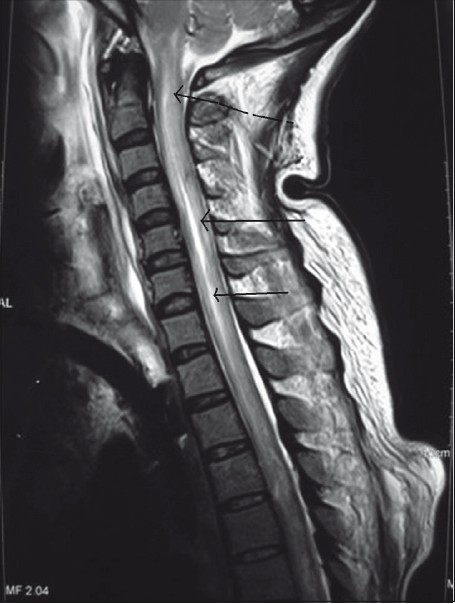Translate this page into:
Delayed presentation of spinal cord trauma
Address for correspondence: Dr Pramendra Agrawal, Jai Prakash Narayan Apex Trauma Centre, All India Institute of Medical Sciences, A-148, sector-15, Noida, 201 301, UP, India. E-mail: pramendraagrawal@yahoo.com
This is an open-access article distributed under the terms of the Creative Commons Attribution-Noncommercial-Share Alike 3.0 Unported, which permits unrestricted use, distribution, and reproduction in any medium, provided the original work is properly cited.
This article was originally published by Medknow Publications and was migrated to Scientific Scholar after the change of Publisher.
Sir,
Spinal cord injuries (SCI) may manifest later despite absence of any clinical signs on initial presentation. Neurological examination, X-rays and computed tomography (CT) scan are usually done to rule out spine injury. We encountered a case wherein the patient had delayed presentation of SCI following whiplash mechanism of trauma despite normal imaging.
A 32-year-old female was admitted with alleged history of motor vehicle accident. She had a fall from motor bike after her scarf (dupatta) got entangled in the wheelsand sustained neck trauma, auto amputation of right upper limb and thoracic trauma. After receiving primary treatment in a community hospital, she was referred to our center with cervical collar and oxygen supplementation. Bilateral intercostal drains were also inserted for bilateral hemothorax. On admission she was conscious, airway was patent and air entry was bilaterally equal. She was tachypneic and pulse oximetry showed oxygen saturation of 82%. Her blood pressure was 112/72 mm Hg and pulse rate was 118/minute. She had subcutaneous emphysema over anterior chest and a circumferential bruise around the neck. Airway was secured with cuffed endotracheal tube while maintaining manual in line stabilization (MILS) and was mechanically ventilated. Noncontrast computed tomography (NCCT) of head and cervical spine revealed a 4 mm rent in anterior wall of trachea at level of C6–7 Contrast-enhanced computed tomography (CECT) thorax and abdomen revealed bilateral lower lobe lung contusions. There was no evidence of vertebral fracture or spinal cord compression. She had intact sensory and motor functions. On the 4 th day of injury, she developed quadriparesis, episodic bradycardia and hypotension. NCCT head and spine were repeated and found to be normal. Subsequently, magnetic resonance imaging (MRI) brain and spine was done, which showed spinal cord ischemic changes extending from brain stem up to thoracic segments (T4 )[Figure 1]. The quadriparesis progressed to quadriplegia within 4 hours. The vibration and proprioception senses were preserved despite loss of pain and temperature sensation. Neurology and neurosurgery consultations were sought and steroid therapy was initiated. Other supportive treatment was continued. The patient died after 50 days of hospital stay due to sepsis and multiple organ dysfunction syndrome.

- MRI showing ischemic changes from brainstem to T4 thoracic segment
Initial trauma to spinal cord is typically secondary to traction and compression forces. Direct compression of neural elements by bone fragments, disc material and ligaments damages both the central and peripheral nerves. Blood vessel damage might also occur, which leads to ischemia. Loss of auto regulation and spinal shock ensues systemic hypotension exaggerating ischemia.[1] In our case, the quadriplegia appeared 4 days after injury, which is unusual. The exact mechanism of SCI in our patient remains a matter of speculation; however, one of the hypothesis is that extension injury of the spinal cord resulted in intimal tear of vessels (anterior spinal artery) supplying it, which acted as a nidus for thrombotic occlusion of vascular supply. This might have resulted in anterior spinal artery syndrome. It could also be subacute progressive ascending myelopathy (SPAM) which is a rare, poorly understood neurological complication of spinal cord injury.[2] The hypothesis includes vascular injury, further mechanical insult, infection and immune-mediated injury, (apoptosis).SPAM is a rare disorder, unrelated to syrinx formation or mechanical instability, that may gradually emerge within the first 1–2 weeks after a SCI.[3]
To conclude, spinal cord injury must always be suspected in all polytrauma patients, depending on the mechanism of injury[45] and SCI may present even a few days after trauma despite an initial nascent course. MRI is a sensitive modality for diagnosis of such cases.[6] Safety practices during work and recreation can prevent many spinal cord injuries. Defensive driving and wearing appropriate clothing greatly reduces the risk of serious injury.
References
- Update on the pathophysiology and pathology of acute spinal cord injury. Brain Pathol. 1995;5:407-13.
- [Google Scholar]
- Subacute delayed ascending myelopathy after low spine injury: case report and evidence of a vascular mechanism. Spinal Cord. 2006;44:322-5.
- [Google Scholar]
- ascending myelopathy after spinal cord injury: Report of three cases. J Neurosurg. 2000;93:294-9.
- [Google Scholar]
- Guidelines for management of acute cervical spinal injuries. Neurosurgery. 2002;50:S1-6.
- [Google Scholar]
- Acute traumatic central cord syndrome: Magnetic resonance imaging and clinical observations. J Neurosurg. 2002;96:29-33.
- [Google Scholar]





